Is there any food that reflects the beauty of Judaism more than a freshly baked challah? Jews and non-Jews alike love the flavor and shape of this delicious eggy bread. But challah is so much more than just bread. The tradition of challah is a very spiritual one; for observant Jews, it is a way to directly connect with the spiritual energy of God. In fact, baking challah is considered an important blessing in the Jewish home.
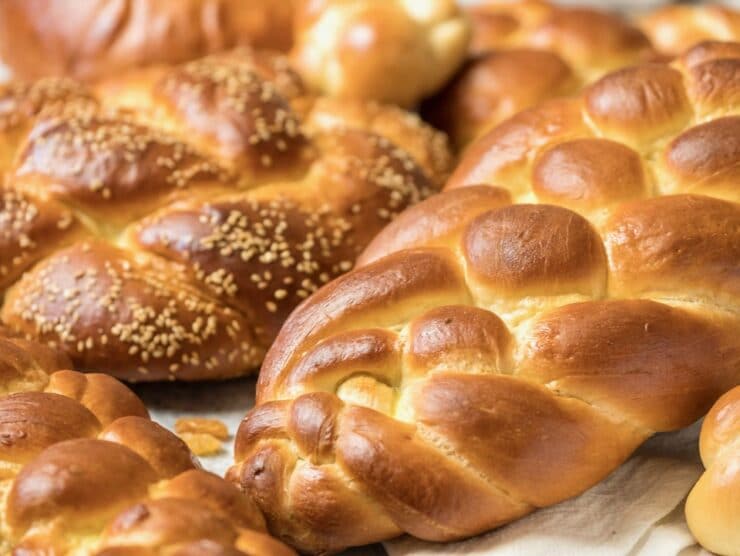
Today, the word challah is used to describe the beautiful loaf of braided bread that appears on Shabbat tables all over the world. In ancient times, challah referred to a small bit of dough that was set aside for the Temple priests as an offering to God:
Of the first of your dough you shall present a loaf as a contribution; like a contribution from the threshing floor, so shall you present it.
Numbers 15:20
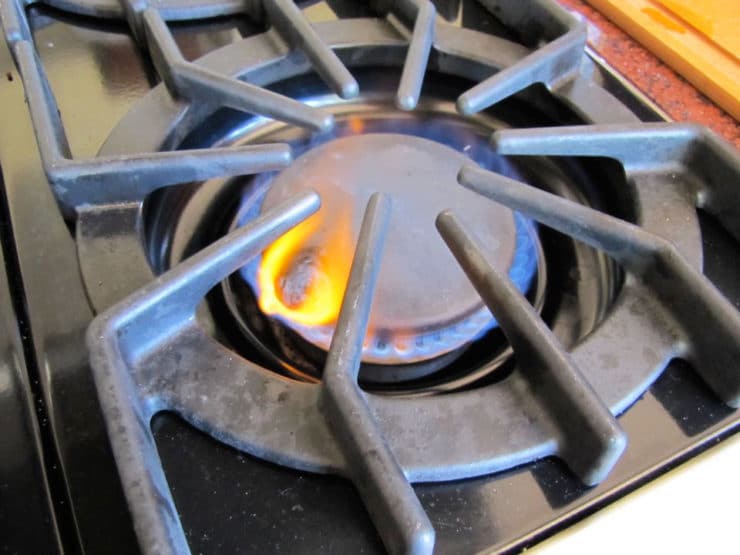
Burning a small portion of dough as an offering is part of the challah blessing.
Traditionally, challah is served on Shabbat and holidays. I like to think of challah as a “special occasion” bread because of the time and effort that goes into making it. You can certainly make challah any day of the year, but in my home the process is reserved for Shabbat and the major Jewish holidays (except for Passover, of course, when leavened bread is not allowed). The smell of freshly baked challah ushers in our weekly Shabbat celebration and puts everybody in a mood of gratitude. As blog reader Rabbi Gershon Steinberg-Caudill put it—“I love it when I finish making my Shabbat Challah. It smells like Shabbat!”
The ritual associated with separating and blessing the challah is a somewhat complex process, dependent on the size of challah you are baking and your level of observance. Customs vary according to Halachic opinion; Ashkenazi and Sephardic traditions approach the blessing differently. If you are interested in learning more about the process of separating challah, there are many guides available online… or ask a trusted rabbi!
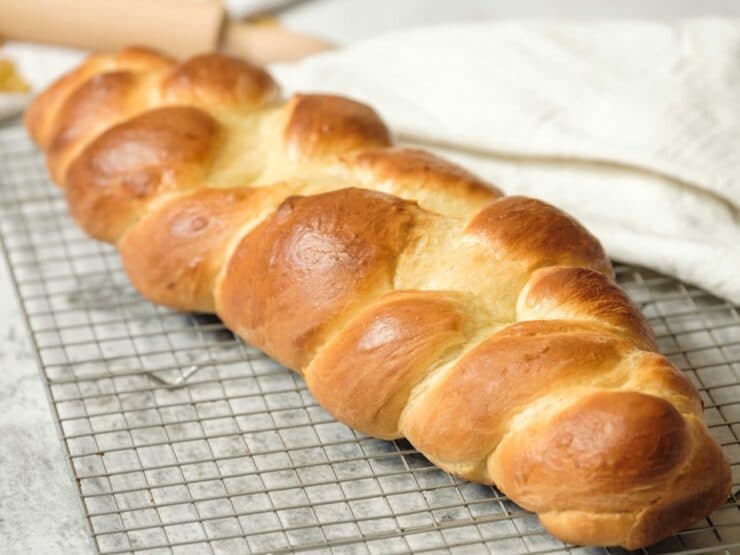
For me, baking challah is like a meditation. Kneading and rising, kneading again, shaping, braiding and baking— it all takes a lot more time than baking brownies from an instant mix. Smelling the bread baking, then seeing your gloriously braided challah on the dinner table, really makes it all worthwhile. I hope this blog inspires you to try it yourself!
The following recipe is my favorite way to make challah, developed after many attempts to create a “foolproof” challah recipe. It’s a rich, moist, eggy challah sweetened with honey. The multiple risings create a beautiful texture, and the egg wash results in a gorgeous golden crust. Feel free to sprinkle your challah with any of the toppings suggested in the recipe. You also can add raisins or chocolate chips to the dough (adding real chocolate will make it a dairy recipe). No matter which way you choose to make it, challah is a delicious way to celebrate Shabbat, or any other holiday.
If you’ve never made challah before, remember to be patient. Baking challah is a simple process, but it does take time and effort. You may need to try it a few times to get a “feel” for the dough. If you follow my instructions exactly, you should be fine— I’ve tried to describe each step very carefully and specifically. Comment me if you have any questions.
For instructions on how to braid your challah, click the following link:
Challah Part 2: How to Braid Challah.
Good luck! 🙂
Recommended Products:
We are a participant in the Amazon Services LLC Associates Program, an affiliate advertising program designed to provide a means for us to earn fees by linking to Amazon.com and affiliated sites. As an Amazon Associate I earn from qualifying purchases.
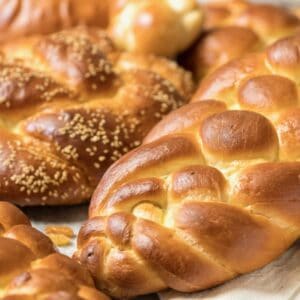
Challah
Ingredients
Dough Ingredients
- 1 1/2 cups lukewarm water, divided
- 1 packet active dry yeast (1 packet is equivalent to 2 1/4 tsp or .25 ounce active dry yeast) - you may substitute 1 3/4 teaspoons of instant yeast or .6 ounce compressed fresh yeast (1 small cake)
- 1 teaspoon sugar
- 1 large egg
- 3 large egg yolks
- 1/3 cup honey
- 2 tbsp avocado oil (I prefer avocado oil for flavor and health reasons - you may substitute sunflower oil or canola oil)
- 2 teaspoons salt
- 4 1/2-6 cups all purpose flour - PLEASE NOTE - if you are using the metric conversion tool on this recipe, the flour is not updating correctly. The correct metric measurements for flour are 562.5 to 750 grams (do not change the recipe serving sizes or it will not work)
Egg Wash Ingredients
- 1 large egg
- 1 tablespoon cold water
- 1/2 teaspoon salt
Optional Ingredients
- Raisins, chocolate chips (1 ½ cups of either)
Optional Toppings
- Sesame seeds, poppy seeds, kosher salt
NOTES
Instructions
- Pour ¼ cup of the lukewarm water (about 110 degrees) into a large mixing bowl. Add 1 packet of active dry yeast and 1 tsp of sugar to the bowl, stir to dissolve. Wait 10 minutes. The yeast should have activated, meaning it will look expanded and foamy. If it doesn’t, your yeast may have expired, which means your bread won’t rise—go buy some fresh yeast! This step Is called "proofing" the yeast - if you're using instant yeast you can skip this step and simply add the yeast to your dry ingredients. If you're using fresh yeast (or compressed or cake yeast), simply stir it into the lukewarm water to dissolve, then add the remaining wet ingredients - no need to wait for proofing.

- Once your yeast has activated, add remaining 1 ¼ cup lukewarm water to the bowl along with the egg, egg yolks, honey, oil, and salt. Use a whisk to thoroughly blend the ingredients together.

- Begin adding the flour to the bowl by half-cupfuls, stirring with a large spoon each time flour is added. When mixture becomes too thick to stir, use your hands to knead.Continue to add flour and knead the dough until it’s smooth, elastic, and not sticky. The amount of flour you will need to achieve this texture varies—only add flour until the dough feels pliable and “right.” If you plan to add raisins or chocolate chips to the challah, incorporate into the dough as you knead.

- Place a saucepan full of water on the stove to boil.Meanwhile, remove the dough from your mixing bowl and wash out the bowl. Grease the bowl with oil. Push the dough back into the bottom of the bowl, then flip it over so that both sides are slightly moistened by the oil.

- Cover the bowl with a clean, damp kitchen towel. Place the bowl of dough on the middle rack of your oven. Take the saucepan full of boiling water and place it below the rack where your dough sits. Close the oven, but do not turn it on. The pan of hot water will create a warm, moist environment for your dough to rise. Let the dough rise for 1 hour, or until the dough doubles in size. This may take longer depending on a number of things, including weather conditions... be patient! It's important to let the dough rise for best results.

- Take the dough bowl out and punch it down several times to remove air pockets.

- Place it back inside the oven and let it rise for 1 hour longer, or until the dough doubles in size.

- Take the dough out of the oven. Flour a smooth surface like a cutting board. Punch the dough down into the bowl a few times, then turn the dough out onto the floured surface. Knead for a few minutes, adding flour as needed to keep the dough from feeling sticky.

- Now your dough is ready to braid. If you plan to separate and bless the challah, do it prior to braiding. Click here to learn how to braid challah.After you’ve braided your challah, place it on a cookie sheet lined with parchment paper (this will catch any spills from your egg wash and keep your challah from sticking to the cookie sheet).Note: I usually only put a single challah braid on a cookie sheet, since they tend to expand a lot when baking.

- Prepare your egg wash by beating the egg, salt and water till smooth. Use a pastry brush to brush a thin layer of the mixture onto the visible surface of your challah. If you're adding sesame seeds or some other topping, sprinkle it on the damp dough now - the egg wash helps it stick. Reserve the leftover egg wash.

- Let the braid rise 30 to 45 minutes longer. You’ll know the dough is ready to bake when you press your finger into the dough and the indentation stays, rather than bouncing back.Heat oven to 350 degrees F. The challah needs to bake for about 40 minutes total, but to get the best result the baking should be done in stages. First, set your timer to 20 minutes and put your challah in the oven.

- After 20 minutes, take the challah out of the oven and coat the center of the braid with another thin layer of egg wash. This area tends to expand during baking, exposing areas that will turn white unless they are coated with egg wash.Turn the tray around, so the opposite side is facing front, and put the tray back into the oven. Turning the tray helps your challah brown evenly—the back of the oven is usually hotter than the front.

- The challah will need to bake for about 20 minutes longer. For this last part of the baking process, keep an eye on your challah—it may be browning faster than it’s baking. Once the challah is browned to your liking, take the tray out and tent it with foil, then place it back in the oven. Remove the foil for the last 2 minutes of baking time.Take the challah out of the oven. At this point your house should smell delicious. You can test the bread for doneness by turning it over and tapping on the bottom of the loaf—if it makes a hollow sound, it’s done. Let challah cool on the baking sheet or a wire cooling rack before serving.

Nutrition

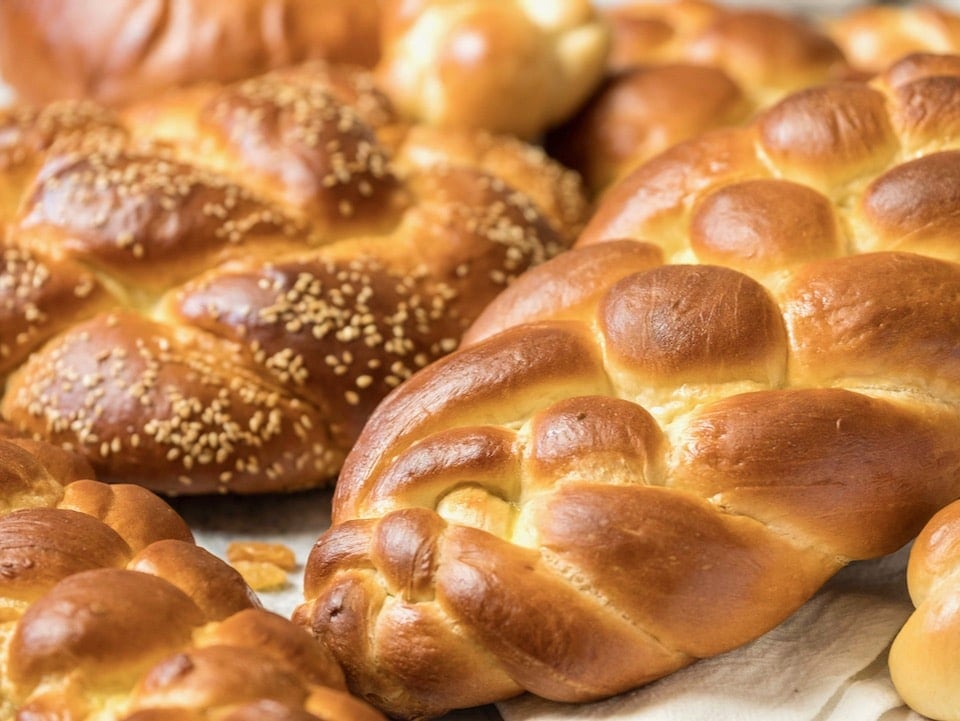
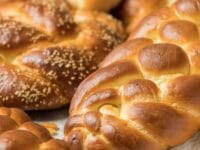
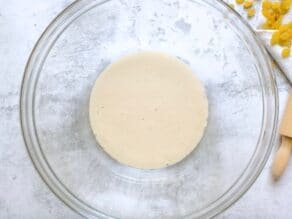
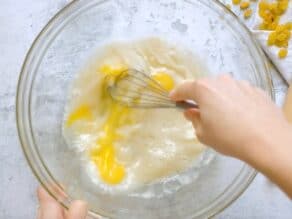
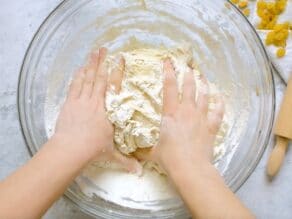
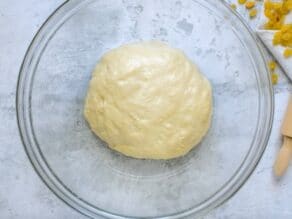
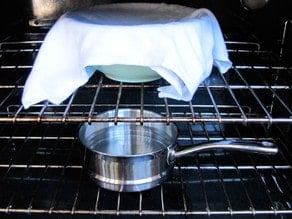
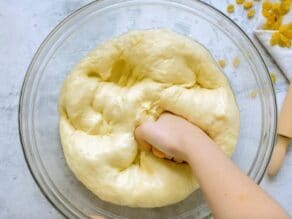
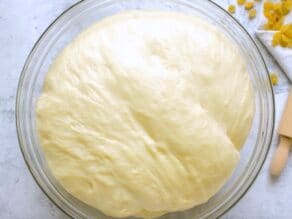
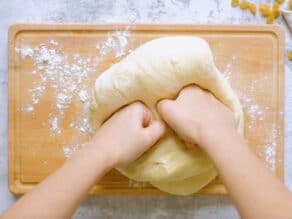

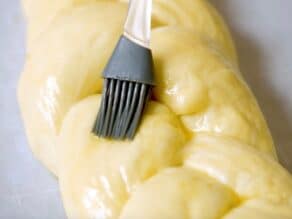
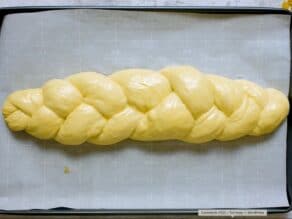
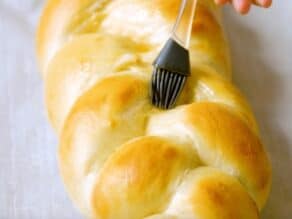
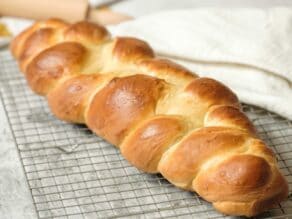


I know I’ve raved about this recipe before. But yesterday I had a craving!!! And I needed buns for hamburgers. So I made a braided pan loaf and 8 burger buns… they buns are the best I’ve ever had and that includes the brioche ones. I just can’t get over the perfection of this recipe. I’ve tried for years to get a challah recipe that I can work with. And they’ve all been too dry or too “bready” or just unworkable. This recipe just is so versatile! I use 100g semola remachinata in my loaf bread and that just made the dough richer but not stiffer! I had to convert your recipe to grams as the difference between US measure and Imperial measure is just that annoying! So I’ve based it on 800g flour and a 45% water hydration. With the eggs and flour you call for the hydration is around 60% which makes a beautifully extensible dough which you can make braids and buns and all sorts of grand things. Again thank you for this wonderful challah recipe!
So happy you like the recipe Rod! Thank you for providing your own measurements, I am sure they’ll be helpful to others.
This is my go to recipe every year for Rosh Hashanah, so easy and delicious!
I’d like to add more honey to this recipe, would I need to do any adjustments to the liquid or flour portion of the recipe?
Hi Candice! You can add more honey without any problem– I do this whenever we want a sweeter dough, without changing the recipe otherwise. You may need to add a bit more flour than you’re used to, but it shouldn’t change the basic proportions of the recipe. Just add more flour until the dough feels right.
My first time and it turned out great
If we decide to make 2 regular sized challahs, do you recommend baking one at a time, or both at the same time?
You can bake both at the same time on different baking sheets, if your oven has the space for it. Just keep an eye on the browning, as different parts of the oven can heat faster or slower – you want them evenly browned. Tent with foil if you find they are browning too quickly.
This challah is delicious. The recipe was easy to follow. Thank you so much.
i made yeast free challah last week. The dough turned out sticky and it was impossible to braid. What a mess. This recipe was so superior with excellent directions on how to make the challah, more Yiishket, and great braid-making directions. I can’t wait to serve it for Shabbat tomorrow.
Excellent! Shabbat Shalom Heidi. 🙂
First time making challah and they came out beautifully. Used 4-1/2c flour and rapid rise yeast. Topped with Kosher salt after egg wash. Let rise 2x and after braiding. Delicious.
So fun and easy to make and gives me shalom!! Thank you for this. My sister shared this with me. My kids love Challah bread makes Shabbat that much more enjoyable. Making it for our thanks giving dinner and I put half in a loaf pan for leftover Turkey sandwiches we will enjoy through Shabbat im sure!
Love your bread recipe!!! I don’t buy bread much anymore, because it’s cheaper to make it. The other thing is it taste so much better and I don’t like the other breads anymore. Thank you
Hi. I just want to say thank you for posting such a beautiful recipe and a wonderful presentation/ explanation of how to make and braid challah. Yours was the first recipe I had tried for making challah on my first attempt (which turned out nicely). When I was asked to bring challah to Rosh Codesh gathering last month (or maybe the one before…), I baked 4 loaves, but kept one at home. The other 3 loaves, we took and everyone there was amazed and impressed with the bread. Now, for Erev Shabbat, I have been asked to bring 6 loaves. I must add that choosing to do so all in one day is not a good idea. As far as anything that I did different, I only used corn oil n the recipe, and olive in the bowl to rise. Something about Canola doesn’t seem right to me, so I did opt for that change. Otherwise, there is no other thing that I would change about this recipe. Bread is such an amazing staple, and challah just kind of plugs you into more of the culture and roots. May you be blessed always and thank you for all of your recipes.
My in-laws and other relatives are coming for Thanksgiving (over a month away). I want to make the Challah several times to get the dough/consistency right.
For Thanksgiving dinner, I want to make rolls. I read the braiding article so I have a good idea on how to make them.
My question, if I use your recipe, how many rolls should I divide the dough into? The braiding article wasn’t clear on how much dough I should use for each roll.
Hi Jonathan, I usually just eyeball it. I would need to revisit this next time I make challah rolls to give you a more precise measurement.
I love making your challah, actually made the apple honey one for rosh hashanah. I have a problem with the first rise, it always takes much longer, literally over 2 hours……I put it in the oven with boiling water underneath for 90 minutes and actually have to boil the water again for about an hour longer for it to rise. I live in Maryland and its been really hot here so my air conditioning has been on I don’t know if thats a factor but I always have issues with it rising. In the end it does come out but its a little frustrating. The yeast does work so its not that, I just don’t know. Also when making 2 loaves, is it better to keep one dough on the side in a bowl with damp cloth till I”m ready to braid? Last time with the apples the other one was a little dense? thank you, Happy Healthy New Year to you!!
Hi Robin! Yes the first rise sometimes takes some patience. It’s important to proof active dry yeast, and give it time to get foamy before you start making the dough. Have you tried rapid rise yeast? It tends to create a faster rise and you only need one rise with it versus two with active dry. You would need .1875 ounces of rapid rise per batch of challah (1 tsp + a scant 3/4 tsp). Skip dissolving the yeast in water with sugar and add the additional 1/4 cup lukewarm water and sugar directly to your dough together with the other liquid ingredients, so you’re retaining the same total amount of liquid. Do make sure you use warm water if going this route (110 or 120 degrees – not hot, but nice and warm). You can definitely keep the second half of dough in the bowl with cloth covering, it will stay moist that way.
This challah is great. It’s my first time baking with yeast and the instructions were well laid out. I added cinnamon and vanilla and used 3tsp yeast. Well done Tori. This challah is an excellent bread.
Glad you enjoyed it Diane!
This is hands down the best challah recipe and braiding tutorial I’ve found. I’ve tried a bunch over the years but found yours a couple years ago and haven’t looked back. BEST EVER!
Hi Tori,
I am excited to make this bread. Your flour quantity is a range, 4.5-6 cups. How does one decide how much flour to use?
Thanks
Hi J, please read through the recipe instructions which provide in-depth guidance on this. Good luck, enjoy!
Wow okay this is by far the best recipe I’ve followed and the only challah recipe I need. Your steps and descriptions of the feel and consistency of the dough are so so helpful. Thank you!
I am a newbie to cooking and love tsoureki the Greek version of challah bread. I’ve always wondered how to make it and this is the first thing with some technique I am learning. It makes it easier because I love eating it so I’ve made it nearly every day for a week! Anyway, it’s come along very nicely, have made some really nice looking challahs and have finally worked out how to get the chewy gummy texture instead of the bread type taste. Amazing recipe helped me so much! Cheers!
This has been my go-to Challah recipe for several years. We love it. I even gave the recipe to my son and he makes it all the time too. We live at high elevation (7500 ft), and I have figured out rise time adjustments that help make it come out great. My questions is, I want to make some mini challah loaves. Do you know how long I would bake them for? I am assuming 40 minutes, like a normal loaf, would be way to long. Any suggestions?
Hi – thought I’d share my experience since I also make two small loaves (and usually freeze one) instead of one large loaf. I have six slots in my oven and put my rack on the 2nd slot from the bottom so my bread sits as close to mid-oven as possible. I use the convection bake feature and set it at 350. I do the first bake for 20 minutes, remove the bread, add more egg wash, turn the pan and return the bread to the oven with the foil tents. Then I change my oven setting from Convection bake to just regular bake at 345 and set timer for 10 mins, check the internal temp and continue cooking until the center of my loaves reach 190 degrees. I strongly prefer the temp method to knocking on the bottom of the loaf and trying to decide if it is “hollow” sounding or not. I hope this helps – good luck to you!
This was a delicious recipe but I was wondering if you had any directions on how to make it “egger”. I usually like my challahs on the sweeter and eggy side and this one was a bit more savory/more like a water challah. Thanks!
The recipe was easy to follow and the bread came out perfect! The recipe yielded one, large loaf which provided plenty of portions, plus leftovers! Next time, I’ll split the dough into 2 equal portions to make 2 smaller loaves.
Glad it worked out for you! Yes, if making one challah, it will be very large – but impressive, loaf!